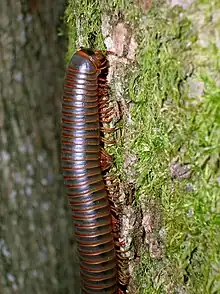Narceus americanus
Narceus americanus is a large millipede of eastern North America. Common names include American giant millipede,[1] worm millipede, and iron worm.[2] It inhabits the eastern seaboard of North America west to Georgetown, Texas, north of the Ottine wetlands.[3] It has a nearly cylindrical gray body, reaching a length of 4 inches (100 mm).[4] They can be commonly found in or under decaying logs from March to October.[5] When threatened, they sometimes curl up or release a noxious liquid that contains large amounts of benzoquinones which can cause dermatological burns. This fluid may irritate eyes or skin. Many other millipedes secrete hydrogen cyanide, and while there have also been claims that N. americanus releases hydrogen cyanide, they are unsubstantiated. They do, however, excrete a substance that causes a temporary, non-harmful discoloration of the skin known as millipede burn.[6]
| Narceus americanus | |
|---|---|
 | |
| Scientific classification | |
| Domain: | Eukaryota |
| Kingdom: | Animalia |
| Phylum: | Arthropoda |
| Subphylum: | Myriapoda |
| Class: | Diplopoda |
| Order: | Spirobolida |
| Family: | Spirobolidae |
| Genus: | Narceus |
| Species: | N. americanus |
| Binomial name | |
| Narceus americanus (Palisot de Beauvois, 1817) | |
Ecology and behavior
Diet
N. americanus are detritivores, primarily consuming decaying wood and leaf litter. They have also been found to feed on deer scat and fresh fruit, preferring these to their typical diet when given the choice.[7] Most feeding activity occurs at night.
Behavior
Though capable of releasing irritating and foul-smelling liquid from ozopores when aggressively disturbed, they can typically be safely handled by humans and are not uncommon on the arthropod pet market.[8]
Their cuticle is somewhat water permeable, so they seek out damp or humid environments and have exhibited specific behaviors in response to desiccation stress. If exposed to a dry or actively desiccating environment, they will first expend energy trying to find a more favorable environment, and if this fails they reflexively curl into the typical defensive position. This position closes spiracles located at the base of legs, preventing further water loss.[9] From a partially dehydrated state they can reabsorb moisture from high-humidity air, but moisture-rich food is necessary for complete recovery to a fully hydrated state. Molting while burrowed into the ground or into rotting wood can also be a response to chronic dehydrating conditions.
Burrowing[10]
Burrowing is initiated by the millipede picking up sediment grains with its mandibles and using legs to pass them along its body segments, where the sediment is then deposited at the posterior end of the body. This process from start to finish can take anywhere between five and sixty minutes, depending on the size of the burrow and qualities of the soil.
Burrows can be used as temporary or more permanent dwellings, and are used to escape dry or cold surface conditions. Millipedes will typically spend non-feeding time in their burrows, which is why they are difficult to find during the day. Molting is almost exclusively done in burrows.
Reproduction[11]
The average lifespan of these millipedes is unknown, but they can live up to eleven years in captivity or in the wild. Sexual maturity is not reached until 1–2 years of age.
Mating occurs at the beginning of spring through to early summer. Males mate via transfer of a spermatophore, and females are able to store this sperm to fertilize eggs at a later time. Other millipede species may lay 20–300 eggs, but N. americanus lay just one egg in a nest made of chewed leaf litter and excrement. The female millipede will wrap herself around the egg and nest until it hatches several weeks later, producing a millipede with seven body segments and only three leg pairs. The number of body segments and leg pairs are increased with each molting, and there is no parental investment after egg hatching.
Photos
 On floor, note waves of legs
On floor, note waves of legs Curled in defensive position
Curled in defensive position Defensive position
Defensive position On a finger
On a finger Closeup of the head
Closeup of the head
See also
- Tylobolus, a similar-looking genus in the Western U.S.
- Narceus gordanus, a member of the same genus
References
- Millipedes (Diplopoda), Jeff's Nature Page
- Walker, Matt J; Stockman, Amy K; Marek, Paul E; Bond, Jason E (2009). "Pleistocene glacial refugia across the Appalachian Mountains and coastal plain in the millipede genus Narceus: Evidence from population genetic, phylogeographic, and paleoclimatic data". BMC Evolutionary Biology. 9 (1): 25. doi:10.1186/1471-2148-9-25. PMC 2652443. PMID 19183468.
- Stephen Welton Taber & Scott B. Fleenor (2005). "Crustaceans, millipedes, and centipedes". Invertebrates of Central Texas Wetlands. Texas Tech University Press. pp. 263–272. ISBN 978-0-89672-550-8.
- Jennifer Frick-Ruppert (2010). "Railroad worms and millipedes: predators and prey". Mountain Nature: a Seasonal Natural History of the Southern Appalachians. University of North Carolina Press. pp. 106–108. ISBN 978-0-8078-7116-4.
- "American Giant Millipede Complex". iNaturalist.
- J. E. Percy, J. Weatherston (1971). "Studies of physiologically active arthropod secretions. V. Histological studies of the defence mechanism of Narceus annularis (Raf.) (Diplopoda: Spirobolida)". Canadian Journal of Zoology. 49 (2): 278–279. doi:10.1139/z71-040. PMID 4925896.
- Silva, C. M., and R. L. Stewart. "Behavioral Dietary Preferences of Narceus americanus in a Controlled Environment."
- "Giant Pink Foot Millipede (Narceus americanus)".
- O'Neill, Robert V. (1969). "Adaptive Responses to Desiccation in the Millipede, Narceus americanus (Beauvois)". The American Midland Naturalist. 81 (2): 578–583. doi:10.2307/2423992. ISSN 0003-0031. JSTOR 2423992.
- Bowen, Jared J.; Hembree, Daniel I. (2014-04-22). "Neoichnology of two spirobolid millipedes: improving the understanding of the burrows of soil detritivores". Palaeontologia Electronica. 17 (1): 1–48. doi:10.26879/395. ISSN 1094-8074.
- Millican, Kelli. "Narceus americanus". Animal Diversity Web. Retrieved 2021-12-08.
External links
 Media related to Narceus americanus at Wikimedia Commons
Media related to Narceus americanus at Wikimedia Commons- "Narceus americanus" at the Encyclopedia of Life